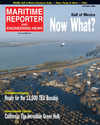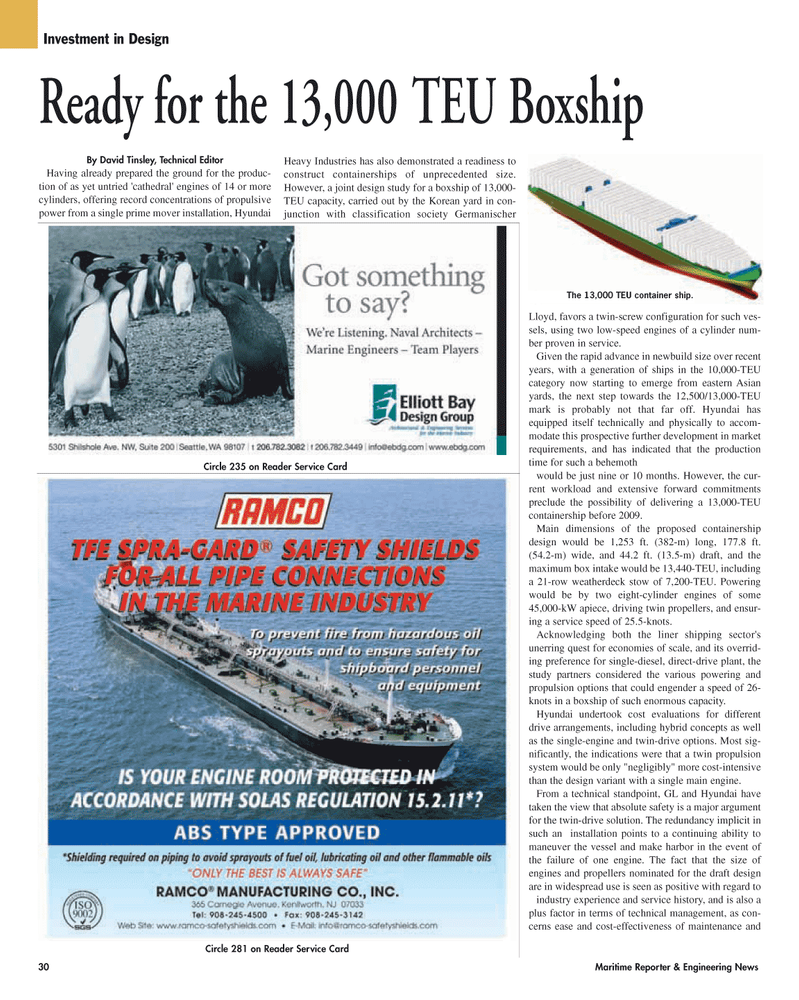
Page 30: of Maritime Reporter Magazine (November 2005)
The Workboat Annual Edition
Read this page in Pdf, Flash or Html5 edition of November 2005 Maritime Reporter Magazine
By David Tinsley, Technical Editor
Having already prepared the ground for the produc- tion of as yet untried 'cathedral' engines of 14 or more cylinders, offering record concentrations of propulsive power from a single prime mover installation, Hyundai
Heavy Industries has also demonstrated a readiness to construct containerships of unprecedented size.
However, a joint design study for a boxship of 13,000-
TEU capacity, carried out by the Korean yard in con- junction with classification society Germanischer
Lloyd, favors a twin-screw configuration for such ves- sels, using two low-speed engines of a cylinder num- ber proven in service.
Given the rapid advance in newbuild size over recent years, with a generation of ships in the 10,000-TEU category now starting to emerge from eastern Asian yards, the next step towards the 12,500/13,000-TEU mark is probably not that far off. Hyundai has equipped itself technically and physically to accom- modate this prospective further development in market requirements, and has indicated that the production time for such a behemoth would be just nine or 10 months. However, the cur- rent workload and extensive forward commitments preclude the possibility of delivering a 13,000-TEU containership before 2009.
Main dimensions of the proposed containership design would be 1,253 ft. (382-m) long, 177.8 ft. (54.2-m) wide, and 44.2 ft. (13.5-m) draft, and the maximum box intake would be 13,440-TEU, including a 21-row weatherdeck stow of 7,200-TEU. Powering would be by two eight-cylinder engines of some 45,000-kW apiece, driving twin propellers, and ensur- ing a service speed of 25.5-knots.
Acknowledging both the liner shipping sector's unerring quest for economies of scale, and its overrid- ing preference for single-diesel, direct-drive plant, the study partners considered the various powering and propulsion options that could engender a speed of 26- knots in a boxship of such enormous capacity.
Hyundai undertook cost evaluations for different drive arrangements, including hybrid concepts as well as the single-engine and twin-drive options. Most sig- nificantly, the indications were that a twin propulsion system would be only "negligibly" more cost-intensive than the design variant with a single main engine.
From a technical standpoint, GL and Hyundai have taken the view that absolute safety is a major argument for the twin-drive solution. The redundancy implicit in such an installation points to a continuing ability to maneuver the vessel and make harbor in the event of the failure of one engine. The fact that the size of engines and propellers nominated for the draft design are in widespread use is seen as positive with regard to industry experience and service history, and is also a plus factor in terms of technical management, as con- cerns ease and cost-effectiveness of maintenance and 30 Maritime Reporter & Engineering News
Investment in Design
Ready for the 13,000 TEU Boxship
The 13,000 TEU container ship.
Circle 281 on Reader Service Card
Circle 235 on Reader Service Card
MR NOVEMBER 2005 #4 (25-32).qxd 10/28/2005 10:00 AM Page 30

 29
29

 31
31
